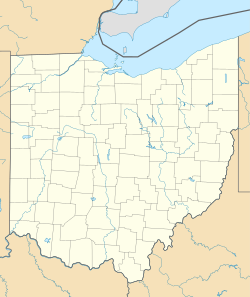Aullwood House and Garden
Aullwood House and Garden | |
 A stream on the Aullwood House Grounds | |
| Nearest city | Dayton, Ohio |
|---|---|
| Coordinates | 39°52′5″N 84°16′32″W / 39.86806°N 84.27556°W |
| Architect | Marie Aull [1] |
| Architectural style | Craftsman[1] |
| NRHP reference No. | 99000092[1] |
| Added to NRHP | 1999-02-05[1] |
Aullwood House and Garden is a registered historic site near Dayton, Ohio, listed in the National Register on 1999-02-05.

The property once served as home for Dayton-area industrialist John Aull and his wife, Marie. The garden includes a mix of native and nonnative plants,[2][3] and is home to many bird and butterfly species.[4] Today, the garden is one of twenty-five properties cared for by Five Rivers MetroParks. There are guided tours of the 32-acre (13 ha) gardens.[5]
Marie Aull
[edit]Marie Sturwold Aull (1897-2002) is considered "the godmother of the Miami Valley environmental movement."[6][7][8] Born in Cincinnati, Ohio, to a family of avid gardeners, she grew up with a passion for gardening and the environment. She went on to take botany, biology, and bird study courses at the University of Cincinnati.[9]
She is credited for initiating the first National Audubon Society nature center in the Midwest when 70 acres of her property was gifted to the Audubon Society in 1957.[6][10] When a neighboring farm was put up for sale, Marie purchased the property and the farm was converted into an educational farm.[11] Marie continued to live in her home until the age of 104 while providing public access to the gardens.[12]
Marie financially contributed to the purchase of public land for the Dayton park district. She would later donate her home and garden property to an organization that would become the Five Rivers MetroParks.[9]
References
[edit]- ^ a b c d "National Register Information System". National Register of Historic Places. National Park Service. June 30, 2007.
- ^ Buttala, Lee (March 25, 2021). "The Self-Taught Gardener: Leaving a legacy". The Berkshire Edge. Retrieved June 26, 2025.
- ^ "Datyon -- Aullwood Garden". Smithsonian Gardens. Retrieved June 26, 2025.
- ^ "Aullwood Garden MetroPark". Birding Hotspots. February 11, 2023. Retrieved June 26, 2025.
- ^ John H. Russell & Thomas S. Spencer (July 28, 2005). Gardens Across America, East of the Mississippi: The American Horticulatural Society's Guide to American Public Gardens and Arboreta. Taylor Trade Publishing. p. 314. ISBN 9781461733669. Retrieved May 8, 2013.
- ^ a b DeLuca, Leo (February 1, 2019). "Dayton History". Dayton Magazine. Retrieved June 26, 2025.
- ^ "Marie Aull Tribute Garden". The Garden Club of Dayton. Retrieved June 26, 2025.
- ^ Doda, Craig (May 23, 2021). "Marie Sturwold Aull". The Historical Marker Database. Retrieved June 26, 2025.
- ^ a b Staples, Sarah (2015). "Guide to Marie Aull Papers (MS-501)". Wright State University Libraries. Retrieved June 26, 2025.
- ^ Evans, Brent (1998). How to create and nurture a nature center in your community. Austin: University of Texas Press. pp. 19:20. ISBN 0292720971. Retrieved July 19, 2025 – via Internet Archive.
{{cite book}}: CS1 maint: url-status (link) - ^ Willis, Daniel (February 3, 2022). "Aullwood Nature Center and Farm". Clio. Retrieved June 26, 2025.
- ^ Wilde, Renee (May 1, 2023). "Half-ton of invasive plants removed at Aullwood's 11th Annual Big Pull". WYSO. Retrieved June 26, 2025.
External links
[edit]![]() Media related to Aullwood House and Garden at Wikimedia Commons
Media related to Aullwood House and Garden at Wikimedia Commons
- Aullwood Garden MetroPark - official site
- National Register of Historic Places in Montgomery County, Ohio
- Houses on the National Register of Historic Places in Ohio
- Houses in Montgomery County, Ohio
- Protected areas of Montgomery County, Ohio
- Tourist attractions in Montgomery County, Ohio
- Parks in Ohio
- Gardens in Ohio
- Parks on the National Register of Historic Places in Ohio
- Dayton-Springfield-Greenville Registered Historic Place stubs
- United States garden stubs




